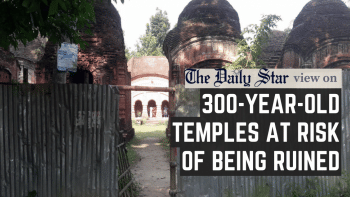Preserve historic Dinajpur shrine properly

Another day, another painful reminder of the poor state of historic sites in Bangladesh – this time, it is a shrine dating back nearly six centuries. The site, locally known as the Chehel Gazi Pirer Mazar, is located in Dinajpur, about three kilometres off the district city. According to a report by Prothom Alo, it is at the risk of being destroyed and thus forever lost to history because of the lack of renovation efforts. What's worse, it is not even recognised as a heritage site by the Department of Archaeology.
The shrine is believed to contain the remains of 40 Islamic preachers – hence Chehel, which is Persian for forty – who once came to this land. The construction of the surrounding mosque was traced to December 1, 1460, based on a reading of one of the three inscriptions recovered from the mosque in 1847 by the then deputy commissioner of Dinajpur. One of those inscriptions is now at the district museum. Today, the site, decayed through the years and lack of care, remains in a precarious state, with about 80 percent of it estimated to have been damaged.
It's shocking to think that a site of such historical and religious importance would be left to the elements. According to law, any ancient monument or place of historical, ethnological, anthropological, military or scientific value that dates back at least a hundred years should be considered within the ambit of antiquities. But those at the Department of Archaeology are yet to recognise the shrine, let alone extend institutional protection to it, nor do they have, strange as it may seem, any information about it.
What could be the reason for such inaction and negligence? We know the answer. We have seen this happen too many times to discount the latest incident as an isolated one. We have seen how even heritage sites that are officially recognised have been falling into ruins or getting occupied/damaged because of neglect by the state. Only last week, we commented on the recovery of Brajo Niketan, a palatial residence of a British-era zamindar, from the clutches of local influentials in Nawabganj, Dhaka. The week before, we had a report about some 300-year-old temples on the bank of the Bhairab River in Jashore that are at the risk of being ruined because of lack of initiatives by the government. Despite having laws, court directives and separate state bodies in charge of such sites, lack of accountability and mismanagement have frequently come in the way of the all-too-important task of preserving history for posterity.
This is really disturbing. We urge the government to take steps to properly protect and preserve all historic sites in the country, including the 600-year-old shrine in Dinajpur. We need these sites to keep reminding us of our roots. A nation without a consciousness of its past cannot fare well in the future.


 For all latest news, follow The Daily Star's Google News channel.
For all latest news, follow The Daily Star's Google News channel. 








Comments